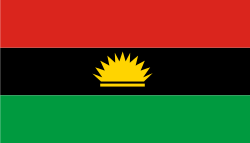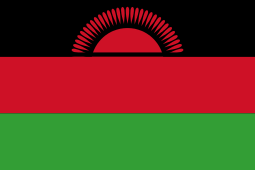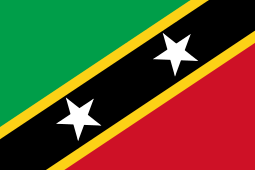Pan-African flag
| Part of the Politics series on |
| Pan-African Topics |
|---|
 |
|
People
|
|

The Pan-African flag — also known as the UNIA flag, Afro-American flag and Black Liberation Flag — is a tri-color flag consisting of three equal horizontal bands of (from top down) red, black and green. The Universal Negro Improvement Association and African Communities League (UNIA-ACL) formally adopted it on August 13, 1920 in Article 39 of the Declaration of the Rights of the Negro Peoples of the World,[1] during its month-long convention at Madison Square Garden in New York City.[2][3] Variations of the flag can and have been used in various countries and territories in Africa and the Americas to represent Pan-Africanist ideologies. Several Pan-African organizations and movements have often employed the emblematic tri-color scheme in various contexts.
History

The flag was created in 1920 by members of UNIA in response to the enormously popular 1900 coon song "Every Race Has a Flag but the Coon,"[4] which has been cited as one of the three songs that "firmly established the term coon in the American vocabulary". In a 1927 report of a 1921 speech appearing in the Negro World weekly newspaper, Marcus Garvey was quoted as saying:[5]
Show me the race or the nation without a flag, and I will show you a race of people without any pride. Aye! In song and mimicry they have said, "Every race has a flag but the coon." How true! Aye! But that was said of us four years ago. They can't say it now....
The Universal Negro Catechism, published by the UNIA in 1921, refers to the colors of the flag meaning:[6]
Red is the color of the blood which men must shed for their redemption and liberty; black is the color of the noble and distinguished race to which we belong; green is the color of the luxuriant vegetation of our Motherland.
Journalist Charles Mowbray White has asserted that Garvey proposed the colors red, black and green for the following reasons: "Garvey said red because of sympathy for the 'Reds of the world', and the Green their sympathy for the Irish in their fight for freedom, and the Black- [for] the Negro."[7]
According to the UNIA as of recent; the three Pan-African colors on the flag represent: red: the blood that unites all people of Black African ancestry, and shed for liberation; black: black people whose existence as a nation, though not a nation-state, is affirmed by the existence of the flag; and green: the abundant natural wealth of Africa.[8]
The flag later became an African nationalist symbol for the worldwide liberation of people of African origin. As an emblem of Black pride, the flag became popular during the Black Liberation movement of the 1960s. In 1971, the school board of Newark, New Jersey, passed a resolution permitting the flag to be raised in public school classrooms. Four of the board's nine members were not present at the time, and the resolution was introduced by the board's teen member, a mayoral appointee. Fierce controversy ensued, including a court order that the board show cause why they should not be forced to rescind the resolution, and at least two state legislative proposals to ban ethnic or national flags in public classrooms other than the U.S. flag.
In the United States, the flag is presently widely available through flag shops or ethnic specialty stores. It is commonly seen at parades commemorating Martin Luther King, Jr. Day, civil rights rallies, and other special events.
Recent usage
In the aftermath of the refusal of a grand jury to indict a police officer in the shooting of Michael Brown, a Howard University student replaced the U.S. flag on the campus flagpole with a Pan-African flag flying at half-mast.[9][10] The incident resulted in the university president, Wayne Frederick, issuing a statement disapproving the flag-raising by unauthorized personnel.[11][12]
Alternative names
The flag goes by several other names with varying degrees of popularity:
- the UNIA flag, after its originators;
- the Marcus Garvey flag;
- the Universal African flag;
- the International African flag;
- the Black Liberation flag;
- the Pan-African flag;
- the Black Nationalist, African Nationalist, or the New Afrikan Liberation flag.
- the Bendera Ya Taifa (Kiswahili: Flag of the Nation), in reference to its usage during Kwanzaa.
Although other designs are also considered to be International African flags or Pan-African flags, the horizontal stripes of red, black, and green, originated by the UNIA in 1920, is the design most often referenced.
Derivative flags


The Biafran flag another variant of this one, with a sunburst in the center.
The flag of Malawi is very similar, changed in 2010 to reflect the pan-African flag's order of stripes.


The African National Congress flag is three horizontal stripes, descending black, green, and dark yellow (gold).



The United States Postal Service issued a stamp in 1997 to commemorate Kwanzaa with a painting by fine artist Synthia Saint James of a dark-skinned family wearing garments traditional in parts of Africa and fashionable for special occasions among African-Americans. The family members are holding food, gifts, and a flag. The flag in the stamp may have been meant to represent the Pan-African flag, However, instead of the stripes descending red, black, and green, the stamp's flag transposes the top two bands and descends black, red, and green.
In 2000, artist David Hammons created a work called African-American Flag, which is held by the Museum of Modern Art in New York City. Based on the standard U.S. flag, its stripes are black and red, the field is green, and the stars on the field are black.
In response to the controversy over the flying of the Confederate Southern Cross, an African-American run company called NuSouth created a flag based on the Confederate Naval Jack, with the white stars and saltire outline replaced by green and the blue saltire made black.
Although the Libya is located in Africa and its flag (introduced in 1951 and re-adopted in 2011), resembles a UNIA flag with a wider black band with a star and crescent in the center, it is actually based on the flag of the Cyrenaica Emirate with added red and green bands.
The Flag of Kenya of 1963 is also very similar to the red, black and green flag.
The Flag of Saint Kitts and Nevis is also similar.
Proposed holiday
In 1999, an article appeared in the July 25 edition of The Black World Today suggesting that, as an act of global solidarity, every August 17 should be celebrated worldwide as Universal African Flag Day by flying the red, black, and green banner. August 17 is the birthday of Marcus Garvey.
See also
Notes
- ↑ Wikisource contributors, "The Declaration of the Rights of the Negro Peoples of the World," Wikisource, The Free Library, The Declaration of the Rights of the Negro Peoples of the World (accessed October 6, 2007).
- ↑ 25,000 NEGROES CONVENE :International Gathering Will Prepare Own Bill of Rights. 1920. New York Times (1857-Current file), August 2, Proquest (Last accessed October 5, 2007)
- ↑ Special to The Christian Science Monitor from its Eastern News Office 1920. NEGROES ADOPT BILL OF RIGHTS :Convention Approves Plan for African Republic and Sets to Work on Preparation of Constitution of the Colored Race Negro Complaints Aggression Condemned Recognition Demanded. Christian Science Monitor (1908-Current file), August 17, Proquest (accessed October 5, 2007).
- ↑ "New Flag for Afro-Americans," Africa Times and Orient Review 1 (October 1912):134; Cited in RACE FIRST: The Ideological and Organizational Struggles of Marcus Garvey and the Universal Negro Improvement Association (Westport, Conn.: Greenwood Press, 1987), p43.
- ↑ Garvey, Marcus (March 19, 1927). "Honorable Marcus Garvey, Gifted Man of Vision, Sets Out In Unanswerable Terms the Reasons Why Negroes Must Build in Africa". Negro World (Vol XXII No. 6). Universal Negro Improvement Association.
- ↑ Mcguire, George (1921). Universal Negro catechism: a course of instruction in religious and historical knowledge pertaining to the race. New York: Universal Negro Improvement Association. p. 34. Retrieved 14 March 2016.
- ↑ Garvey Papers Vol. 2, p. 603.
- ↑ "History - Red-Black-Green". The Universal Negro Improvement Association. Retrieved 14 March 2016.
- ↑
- ↑
- ↑
- ↑
References
- "Black Flag," unattributed article in TIME Magazine, December 13, 1971. (re Newark school board controversy)
The Rick James album "The Flag" opens with an A Capella track named "Freak Flag" which references a green, black and red flag.
External links
- Afro-American flags at Flags of the World non-commercial vexillology site
- Sheet music from the American Memory website of the Library of Congress
- 'Fly the Red, Black, and Green' article proposing holiday at The Black World Today, July 25, 1999
- Kwanzaa Stamp U.S. postage depicting similar flag, with explanatory press release
- MoMA Learning an educational exercise based on David Hammons' African-American Flag
- UNIA official website
- Nusouth website and flag